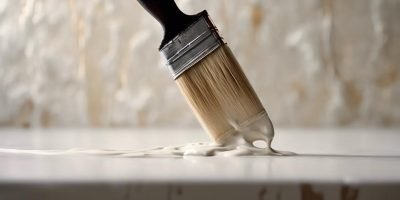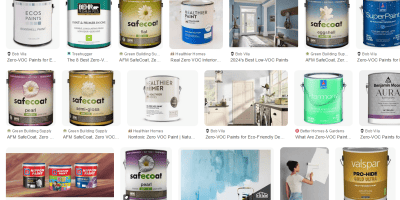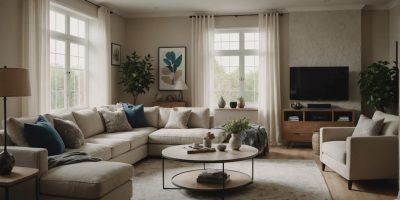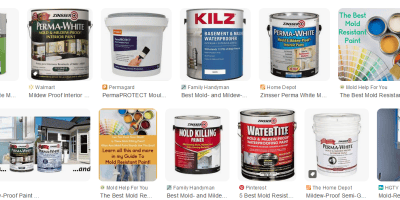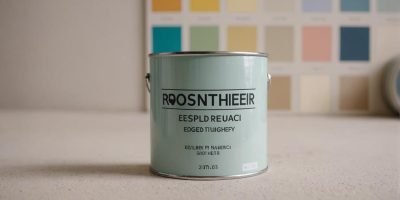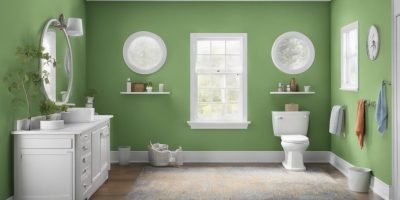Types of Interior Wall Paints
When choosing interior wall paints, consider latex, oil-based, and acrylic options. Latex paint is popular for its quick drying, easy cleanup, and cost-effectiveness, though it can fade and needs well-prepped surfaces. Oil-based paints offer durability and a smooth finish, ideal for high-traffic areas, but have longer drying times and a noticeable odor.
Acrylic paints, often used interchangeably with latex, provide flexibility and resist cracking. For specific finishes, like eggshell or enamel, you'll get varied durability and sheen suited to different room uses. Learn about each type's unique properties to find the perfect match for your space.
Key Takeaways
- Latex paints offer quick drying times and easy cleanup with soap and water.
- Oil-based paints provide exceptional durability and a smooth, luxurious finish.
- Latex paints come in extensive color options for easy room updates.
- Oil-based paints are ideal for high-traffic areas due to their wear resistance.
- Latex paints are cost-effective and require less frequent repainting.
Latex Paints for Interior Walls
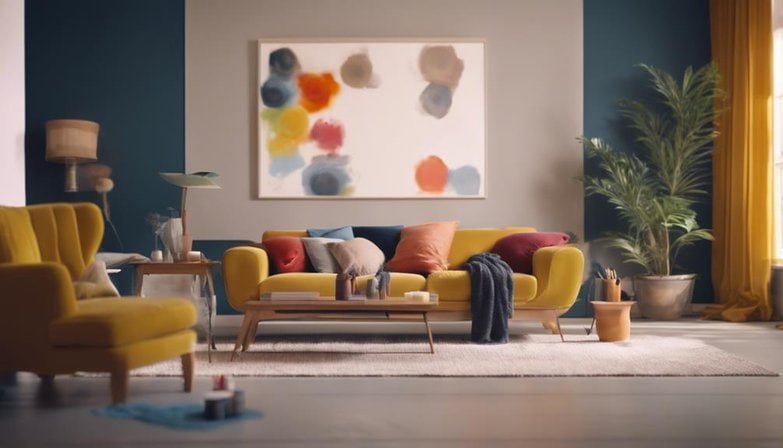
When considering latex paints for your interior walls, you'll find they offer several advantages, such as easy application and quick drying times.
However, it's also crucial to weigh the drawbacks, like their sensitivity to temperature changes.
Understanding both the pros and cons will help you make an informed decision for your painting project.
Pros
Due to their quick drying time and easy cleanup, latex paints offer significant convenience for interior wall projects. You'll appreciate the freedom of faster drying times, meaning you can get back to your daily routine without long waits.
Latex paints also come with impressive durability factors, standing up well to the wear and tear of everyday life. This makes them an excellent choice for high-traffic areas like hallways and living rooms.
When it comes to cost considerations, latex paints provide great value. They're generally less expensive than other types, and their longevity means you won't have to repaint frequently. Application techniques for latex paint are straightforward, whether you're using a brush, roller, or sprayer. Cleanup is a breeze with just soap and water.
Latex paints offer an expansive range of color choices, allowing you to express your personality and create the perfect ambiance in each room.
- More time for what you love: Quick drying times mean less waiting.
- Easy to switch things up: Extensive color options let you change your space effortlessly.
- Stress-free cleanup: Simple soap and water make post-painting a snap.
Ultimately, latex paints give you the freedom to transform your home with ease and efficiency.
Cons
Despite their many advantages, latex paints do have some drawbacks worth pondering for your interior walls. One issue you might face is drying time. While latex paints generally dry faster than oil-based paints, they can still take longer than expected, especially in humid conditions. This waiting period can delay your project, which isn't ideal if you're keen to enjoy your revamped space.
Color fading is another aspect to contemplate. Over time, the vibrant hues you initially loved can lose their brilliance, especially in rooms with a lot of sunlight. This means you might find yourself repainting sooner than you'd prefer.
Smell issues are minimal with latex paints, but they aren't completely odor-free. Sensitive noses might still catch a whiff, particularly during application and drying. Surface preparation is important for a smooth finish, and latex paints demand a well-prepped surface. Skipping this step can lead to peeling or uneven coverage.
Lastly, application difficulties can arise. Latex paints can sometimes show brush marks or streaks if not applied carefully. Achieving a flawless finish requires patience and proper technique, which might be a challenge if you're not an experienced painter.
Oil-Based Paints for Interior Walls
Oil-based paints offer some significant advantages for interior walls, especially in high-traffic areas. You'll appreciate their durability and smooth finish, which can withstand more wear and tear than latex paints.
Additionally, these paints are excellent for creating a glossy, rich look that can improve the aesthetic appeal of your space.
Pros
One major advantage of using oil-based paints for interior walls is their exceptional durability and resistance to wear. You'll find that these paints stand up well to the test of time, especially in high-traffic areas like hallways and kitchens. Their durability benefits guarantee that your walls will look fresh and vibrant for years, reducing the need for frequent touch-ups.
Moreover, oil-based paints offer a broad color variety, allowing you to express your unique style and creativity. This type of paint is also easy to maintain, as it's resistant to stains and can be cleaned with minimal effort. You'll appreciate the smooth, luxurious finish it provides, which gives your rooms a polished, professional look.
Although oil-based paints are known for their durability, they take longer to dry compared to their water-based counterparts. However, they make up for this with their superior durability and resistance to chipping.
Consider these emotional benefits:
- Freedom from constant maintenance
- Confidence in your home's lasting beauty
- Satisfaction from a job well done
Choosing oil-based paint means investing in a long-lasting, vibrant interior that's easy to maintain, offering you the freedom to enjoy your space without constant upkeep.
Pros
You'll appreciate the exceptional longevity and wear resistance that oil-based paints provide for interior walls. These paints are known for their superior durability comparison with other types, making them ideal for high-traffic areas.
With regards to Coverage Efficiency, oil-based paints often require fewer coats than water-based options, saving you time and effort.
Application Techniques for oil-based paints may differ slightly from other types, but with a bit of practice, you'll find them straightforward. Use a natural-bristle brush or a roller designed for oil-based paints to achieve a smooth, even finish. It's crucial to ensure adequate ventilation while painting, as oil-based paints emit stronger fumes than their water-based counterparts.
In terms of Maintenance Tips, oil-based paints are easier to clean. You can simply wipe down the walls with a damp cloth to remove dirt and stains, making them a practical choice for families with kids or pets.
Additionally, the Color Longevity of oil-based paints is impressive. They resist fading and maintain their vibrant hues over time, allowing your walls to look freshly painted for years.
All in all, oil-based paints offer a durable and efficient solution for your interior walls.
Water-Based Paints for Interiors

When considering water-based paints for your interior walls, you'll want to weigh both the benefits and drawbacks.
These paints are known for their quick drying times and easy cleanup, which can make your painting project more convenient.
However, it's also crucial to comprehend any limitations they may have to guarantee you choose the best option for your space.
Pros
Among the many advantages of water-based paints for interiors, you'll appreciate their quick drying time and easy clean-up. These paints are designed to be user-friendly, making your painting projects more efficient and less of a hassle.
Water-based paints offer a high durability rating, ensuring your walls stay vibrant and fresh-looking for years. They come in a wide array of color options, giving you the freedom to choose the perfect shade for any room. In terms of application methods, these paints can be easily applied with brushes, rollers, or sprayers, providing flexibility depending on your preference and the size of the project.
The drying time is notably short, allowing you to complete your painting job quickly and move on to other activities. Additionally, in a cost comparison with oil-based alternatives, water-based paints often come out more budget-friendly, saving you money without compromising quality.
Feel liberated knowing clean-up is a breeze with just soap and water.
Enjoy the variety of colors that let you express your unique style.
Relish the speed as your paint job dries quickly, letting you get back to your life.
These benefits make water-based paints an excellent choice for anyone looking to refresh their interior spaces.
Cons
Despite their many advantages, water-based paints for interiors do come with some drawbacks you should consider. One of the main issues is drying time. While quicker than oil-based paints, they still need sufficient time to fully cure, which can be inconvenient if you're in a hurry to finish your project.
Smell retention can also be a concern. Although generally low in odor, some water-based paints may still hold onto unpleasant smells longer than you'd like.
Additionally, color fading is another concern. Over time, these paints can lose their vibrancy, especially in areas exposed to direct sunlight.
Surface compatibility is something else to watch out for. Water-based paints may not adhere well to all surfaces, particularly glossy or oily ones. This means you might need to invest extra time prepping the walls to ensure a smooth application.
Acrylic Paints for Interior Walls
When evaluating acrylic paints for your interior walls, you'll find they offer several advantages, like durability and easy application.
However, it's crucial to weigh these benefits against potential drawbacks, such as a higher cost compared to other paint types.
Understanding both the pros and cons will help you make an informed decision for your painting project.
Pros
Acrylic paints stand out for their durability and ease of application, making them a top choice for interior walls. You'll love how easy they're to apply, even if you're not a seasoned painter. Acrylic paints dry quickly, so you won't be stuck waiting around for hours.
If you enjoy a wide array of colors, acrylics offer an impressive color variety, letting you express your style freely. They're also budget-friendly, which means you don't have to break the bank to freshen up your space. Plus, the low odor keeps your home smelling fresh, even during the painting process.
Here are some reasons why acrylic paints are a fantastic option:
- Easy application: You won't need to be a pro to get a smooth, even finish.
- Quick drying: Save time and move on with your day faster.
- Color variety: Explore your creativity with countless hues and shades.
Acrylic paints are perfect for those who crave freedom and spontaneity in their home projects. They offer a balance of practicality and aesthetic appeal, ensuring that your walls look great and hold up well over time. Whether you're redecorating a single room or your entire home, acrylic paints make the task manageable and enjoyable.
Cons
While acrylic paints have many benefits, they can sometimes fall short in specific areas. One of the primary challenges you might face is drying time. Though it dries faster than some paints, it still requires a specific window to properly set, which can limit your freedom to move on to the next steps quickly.
Another issue is fading. Acrylic paints, especially when exposed to direct sunlight, can experience fading issues over time. This can be frustrating if you're looking for a long-lasting, vibrant finish.
Odor problems are another concern. The smell of acrylic paint can linger for days, making it uncomfortable to stay in a freshly painted room. This can be particularly bothersome if you have a sensitive nose or allergies.
Surface preparation is also important with acrylic paints. If the walls aren't properly prepped, the paint mightn't adhere well, leading to peeling or uneven coverage. This extra step can be time-consuming and meticulous.
Lastly, cleaning difficulties arise with acrylic paints. While they're generally easy to clean, stubborn stains can sometimes require more effort and specific cleaning agents, which can be a hassle if you're looking for a low-maintenance option.
Enamel Paints for Interiors

When considering enamel paints for your interior walls, you'll want to weigh the pros and cons to make an informed decision.
Enamel paints offer a durable, glossy finish that resists stains and wear, making them ideal for high-traffic areas.
However, they can be more challenging to apply and may require longer drying times compared to other paint types.
Pros
Enamel paints for interiors offer several advantages, including exceptional durability and a glossy finish that heightens the aesthetic appeal of your walls. One of the key durability factors is their ability to withstand wear and tear, making them ideal for high-traffic areas. You'll love how the color retention keeps your walls looking vibrant over time, resisting fading even in sunlight.
When it comes to application ease, enamel paints go on smoothly, providing a professional-looking finish without much hassle. Proper surface preparation enhances the paint's adherence, ensuring a long-lasting result that's both beautiful and resilient. Considering the environmental impact, many modern enamel paints are formulated to be low in VOCs (volatile organic compounds), making them safer for indoor use and better for the environment.
Unmatched Longevity: This paint stands up to the test of time, giving you the freedom to enjoy your space without frequent touch-ups.
Brilliant Shine: The glossy finish reflects your unique style, turning your home into a masterpiece.
Professional Finish: Easy application lets you achieve a high-quality look, freeing you from the constraints of needing professional help.
With these benefits, enamel paints offer a versatile and reliable option for your interior walls.
Cons
Despite their many advantages, enamel paints for interiors come with a few drawbacks you should consider. Firstly, durability concerns might surface over time. While enamel paints are generally tough, they can chip or crack under heavy use, especially in high-traffic areas.
Additionally, fading issues can arise, particularly if the room gets lots of sunlight. The paint can lose its vibrant color, making your walls look dull.
Smell problems are another significant drawback. Enamel paints emit strong fumes that can linger for days, making it uncomfortable to stay in the freshly painted room. Proper ventilation is essential, but even then, the odor can be quite persistent.
Application difficulties also pose a challenge. Enamel paints have a thick consistency, requiring more skill and time to apply evenly. You might find it harder to achieve a smooth finish without visible brush strokes or roller marks.
Lastly, cost factors can't be ignored. Enamel paints tend to be more expensive than other types of interior paints. The higher price, combined with the need for more specialized application tools and techniques, can make the entire project more costly.
Matte Finish Interior Wall Paints
When considering matte finish interior wall paints, you should weigh their benefits and drawbacks. Matte paints offer a rich, non-reflective look that hides wall imperfections well.
However, they can be harder to clean and mightn't be the best choice for high-traffic areas.
Pros
Matte finish interior wall paints offer a sophisticated, non-reflective look that's perfect for creating a cozy atmosphere. You'll find these paints align beautifully with current color trends, allowing you to create a modern, inviting space. The application techniques are straightforward, making it easier for you to achieve a flawless finish without much hassle.
When considering durability factors, matte paints hold up well in diverse low-traffic areas, and they're surprisingly resilient when you select high-quality brands. If you're environmentally conscious, you'll be pleased to know there are plenty of eco-friendly options available. These paints often have low VOCs (volatile organic compounds), making them a healthier choice for your living spaces.
Cost considerations are another point in their favor. While matte paints can range in price, they often provide excellent coverage, meaning you might need fewer coats, saving you money in the long run.
- Warm and Inviting: Ideal for creating a snug, homely feel.
- Elegant and Timeless: Offers a classic look that never goes out of style.
- Versatile and Adaptable: Complements a range of interior design styles effortlessly.
With matte finish paints, you can confidently transform your home into a haven of comfort and style.
Cons
However, matte finish interior wall paints can be tricky to clean, often showing scuffs and marks more easily than other finishes. You'll find that their durability issues can be a significant drawback, especially in high-traffic areas. If you're someone who loves a spotless home, these cleaning difficulties might drive you up the wall.
Unlike other finishes, matte paint can be more prone to fading problems, especially when exposed to direct sunlight over time.
Applying matte finish paint can also present application challenges. It requires a skilled touch to guarantee an even, streak-free coat. If you're a DIY enthusiast, you might find this aspect particularly frustrating. The paint tends to show roller or brush marks more than other finishes, making the task more demanding.
Another concern you might face is the odor. While most paints have some level of smell, matte finishes can sometimes have stronger odor concerns, lingering longer than you'd like. This can be a deal-breaker if you're sensitive to strong smells.
Satin Finish Interior Wall Paints
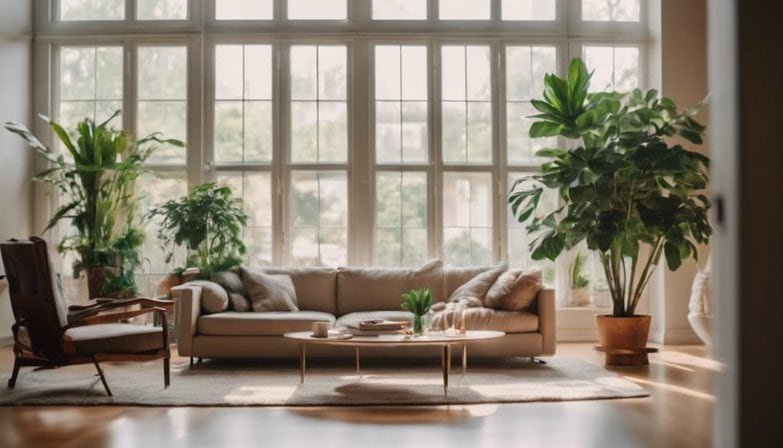
When considering satin finish interior wall paints, you'll find they offer a smooth, velvety look that adds a touch of elegance to your rooms.
They're durable and easy to clean, making them ideal for high-traffic areas.
However, be prepared to address the visible imperfections on the wall, as satin finishes can highlight flaws more than matte options.
Pros
Satin finish interior wall paints offer a perfect balance between durability and elegance, making them a popular choice for many homeowners. When you consider durability factors, satin finishes provide a robust layer that can withstand everyday wear and tear, making them perfect for high-traffic areas like hallways and living rooms.
The broad color variety available guarantees you can find the exact shade to match your aesthetic vision. Plus, satin paints are known for their application ease, allowing for smooth and even coverage that both professionals and DIY enthusiasts can appreciate.
Maintenance tips are crucial to keep your walls looking fresh. Satin finishes are easy to clean; a simple wipe with a damp cloth usually does the trick. This ease of maintenance makes them ideal for families with kids or pets. Additionally, satin paints are cost-effective, offering a long-lasting finish that reduces the need for frequent repainting, saving you both time and money.
Here are a few reasons why satin finish interior wall paints might evoke that sense of freedom you're looking for:
- *Effortless maintenance means more time for what you love.*
- *A wide range of colors lets you express your individuality.*
- *Durable yet elegant, offering beauty that lasts.*
Cons
While satin finish interior wall paints have their benefits, they do come with a few drawbacks you should consider. One of the main issues is drying time. Satin finishes often take longer to dry compared to other types of paint, which can delay your project and limit your freedom to use the space.
Surface preparation is another concern. To get a smooth, even finish, you need to spend extra time ensuring the wall is perfectly clean and free of imperfections. Satin paint tends to highlight any flaws, so skipping this step isn't an option.
Application techniques also matter. You must apply the paint evenly to avoid streaks and roller marks, which requires a bit more skill. If you're not experienced, this could be a frustrating process.
Paint durability can be a mixed bag. While satin paint is generally durable, it's not as tough as semi-gloss or gloss finishes. Over time, you might notice fading issues, especially in areas exposed to sunlight. This means you'll need to repaint more frequently to maintain that fresh look.
Considering these factors, you'll need to weigh the pros and cons before choosing satin finish paints for your interior walls.
Semi-Gloss Interior Wall Paints
When considering semi-gloss interior wall paints, you'll find they offer a shiny, reflective finish that's easy to clean, making them perfect for high-traffic areas.
However, their sheen can highlight imperfections on your walls, so surface preparation is essential.
Let's look at the pros and cons to help you decide if this finish is right for your space.
Pros
Semi-gloss interior wall paints offer a durable finish that's easy to clean, making them ideal for high-traffic areas. These paints stand up well to scrubbing and resist moisture, providing a long-lasting solution for spaces like kitchens, bathrooms, and hallways. The durability factors mean you won't have to repaint as often, freeing up your time for other activities you love.
When it comes to color choices, semi-gloss paints come in a wide range of hues, allowing you to express your creativity and match your unique style. Maintenance is straightforward; simply wiping the walls with a damp cloth will remove most stains and smudges.
Additionally, semi-gloss paints often contain fewer volatile organic compounds (VOCs), contributing to better indoor air quality and offering health benefits for you and your family.
Cost considerations are another advantage; while semi-gloss paints might be slightly more expensive than flat finishes, their longevity and ease of maintenance can save you money in the long run.
Imagine the freedom of enjoying your beautifully painted home without the constant worry of maintaining it.
Here's why you'll love semi-gloss paints:
- Ease of cleaning: Simply wipe away marks and stains.
- Versatility in color: Match any décor effortlessly.
- Long-lasting: Fewer touch-ups mean more free time.
Cons
Despite their many advantages, semi-gloss interior wall paints do have some drawbacks worth pondering. Initially, let's discuss cost considerations. Semi-gloss paints tend to be more expensive than flat or eggshell finishes, which can add up if you're painting a large area.
Additionally, there are health concerns to bear in mind. The higher sheen often means more chemicals, potentially releasing volatile organic compounds (VOCs) into your home, which isn't great for indoor air quality.
Application difficulties are another issue. Semi-gloss paints require a more precise application to avoid visible brush strokes and roller marks. This can make the painting process more time-consuming and challenging, especially if you're a DIY enthusiast.
The environmental impact is also a factor to ponder. The production and disposal of semi-gloss paints can contribute more to environmental degradation compared to other finishes.
Lastly, long-term durability can be a double-edged sword. While semi-gloss paints are durable and easy to clean, they can highlight wall imperfections over time. This means you might find yourself needing to touch up or even repaint sooner than you'd like. Weigh these cons carefully to decide if semi-gloss is right for you.
Glossy Finish Interior Wall Paints
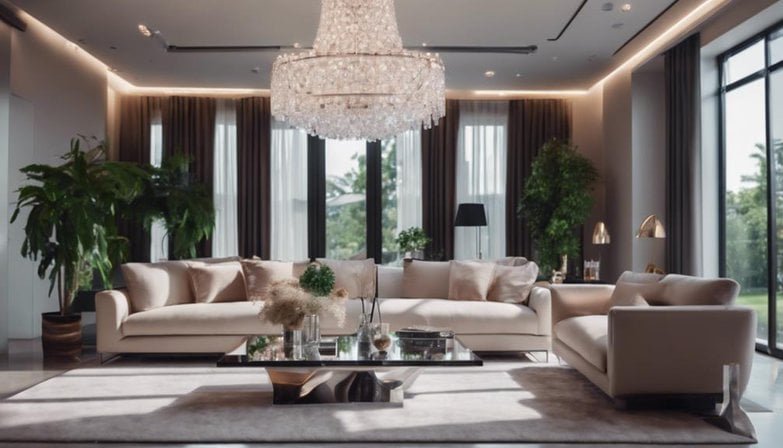
When you choose glossy finish interior wall paints, you'll notice they offer a sleek and shiny appearance that can make your walls stand out.
They're easy to clean and highly durable, making them ideal for high-traffic areas.
However, it's essential to be aware that glossy finishes can highlight wall imperfections, so proper surface preparation is vital.
Pros
Glossy finish interior wall paints provide a sleek and modern appearance that boosts the vibrancy of any room. You'll find that the durability factors of glossy paints are exceptional, making them a wise choice for high-traffic areas. Their hard, shiny surface is resistant to wear and tear, ensuring your walls look pristine for longer periods.
When it comes to application techniques, glossy paints require careful preparation and precise brushwork to avoid streaks and uneven finishes. However, the effort pays off with a smooth, reflective surface that enriches the light and openness of your space.
Color retention is another significant advantage. Glossy paints maintain their hue and brightness over time, resisting fading even under direct sunlight. This means your walls will continue to look vibrant and fresh, adding to the long-term appeal of your home.
Maintenance ease is yet another benefit. Glossy surfaces are easy to clean, as dirt and stains can be wiped away with minimal effort, freeing your time for what matters most.
Lastly, consider the environmental impact. Many modern glossy paints are formulated to be eco-friendly, reducing harmful emissions and contributing to a healthier indoor environment.
Durability and longevity
Ease of maintenance
Vibrant color retention
Cons
One significant drawback of glossy finish interior wall paints is that they can highlight imperfections on the wall's surface. Any dents, cracks, or uneven textures become more noticeable under the shine. If your walls aren't perfectly smooth, glossy paint mightn't be the most suitable choice.
Another issue is the high VOC (volatile organic compounds) content in many glossy paints. High VOCs can lead to allergic reactions, making them a less-than-optimal option for households with sensitive individuals. Additionally, over time, you might notice fading colors. Glossy paints tend to lose their vibrant look quicker than their matte counterparts.
Surface bubbling is another concern. When the paint doesn't adhere properly, bubbles can form, leading to an unsightly appearance. This bubbling often results in paint peeling, which adds more upkeep to your to-do list.
Given these drawbacks, it's crucial to weigh your options carefully. You might love the glossy look, but be prepared for the potential downsides. Always consider the condition of your walls and who'll be living in the space when choosing your paint.
Chalk Paint for Interior Walls
Chalk paint can give your interior walls a unique, matte finish that's perfect for achieving a vintage or shabby chic look.
You'll find that it has its advantages, such as easy application and minimal prep work, but it also comes with some drawbacks, like limited color options and durability concerns.
Let's delve into the pros and cons to help you decide if chalk paint is the right choice for your home.
Pros
You'll love the unique matte finish and easy application that chalk paint offers for interior walls. This paint type stands out with its ability to create a smooth, vintage look that's both stylish and versatile. Chalk paint's key advantages include its durability factors, ensuring long-lasting beauty. It doesn't chip or peel easily, making it a reliable choice for high-traffic areas.
Application ease is another major perk. Even if you're not a seasoned painter, you'll find chalk paint incredibly user-friendly. It adheres well to surfaces without the need for extensive prep work. Plus, its quick drying speed allows you to finish your project faster, giving you more freedom to enjoy your space.
Chalk paint also boasts a wide color variety, enabling you to achieve the exact look you want. From soft pastels to bold hues, the options are plentiful. Maintenance simplicity is another benefit; cleaning surfaces painted with chalk paint is straightforward and hassle-free.
Here are a few reasons why chalk paint will make your interior walls pop:
- Effortless Elegance: Achieve a chic, matte finish with minimal effort.
- Creative Freedom: Wide range of colors to express your style.
- Time Saver: Quick drying times let you enjoy your revamped space sooner.
Cons
Finally, consider the cost implications. Chalk paint tends to be more expensive than standard wall paints, which can add up if you're covering a large area.
Another issue is color fading. Chalk paint's matte finish can look great initially, but over time, it may lose its vibrancy, requiring more frequent touch-ups. Maintenance issues also arise, as chalk-painted walls can be more susceptible to scuffs and marks. You'll need to clean them gently to avoid damaging the finish, which can be a hassle.
Application complexity is another factor. Achieving a smooth, even coat with chalk paint can be tricky, especially if you're not experienced. This paint often requires multiple coats and careful technique, which can be time-consuming and frustrating.
Textured Paints for Interior Walls

Textured paints can add a unique and tactile element to your interior walls, but they come with both advantages and drawbacks.
On the positive side, they can hide imperfections and create a visually interesting surface.
However, they might be harder to apply and remove compared to traditional paint options.
Pros
With textured paints, you can add depth and character to your interior walls, making them a standout feature in any room. These paints offer several benefits that cater to both practical and aesthetic needs.
First, when considering durability, textured paints are a robust choice. They resist wear and tear better than many other types of paint, making them perfect for high-traffic areas.
Cost efficiency is another advantage. Despite their initial higher cost, their longevity means fewer touch-ups and repaints, saving you money in the long run. Additionally, textured paints excel in color retention, maintaining their vibrancy over time even in rooms with heavy sunlight.
Ease of application is another perk. While it may seem challenging at first, many textured paints are designed for straightforward application, whether you're a DIY enthusiast or a professional.
Lastly, let's not forget the environmental impact. Many textured paints are now formulated with low VOCs (volatile organic compounds), making them a more eco-friendly option.
Imagine walking into a room that feels:
- Inviting and warm
- Unique and personal
- Full of character
These benefits make textured paints a compelling choice for those seeking freedom in design and functionality.
Cons
However, there are some drawbacks to using textured paints for interior walls that you should consider before making a decision. Initially, the drying time can be notably longer than that of regular paint. If you're in a hurry to finish your project, this mightn't be the best option. Additionally, textured paints often come with odor issues that can be quite strong and linger for days, making it uncomfortable to stay in the painted area.
Applying textured paint isn't as straightforward as using standard paint. The application difficulty can be a major obstacle, especially if you're not experienced in painting techniques. You'll need to prepare the surface meticulously to make sure the texture adheres properly, which can be time-consuming and labor-intensive.
Achieving color uniformity with textured paints can also be challenging. The texture itself can cause the paint to appear uneven in different lighting conditions, which mightn't be the look you're aiming for.
Lastly, the surface preparation required before applying textured paint is more demanding. Walls need to be clean, smooth, and free from any imperfections to guarantee the best results.
Fire-Resistant Paints for Interiors
When evaluating fire-resistant paints for your interior walls, it's crucial to weigh the pros and cons.
Fire-resistant paints can provide an added layer of safety by slowing the spread of flames.
However, they might be more expensive and could have fewer color options compared to regular paints.
Pros
Fire-resistant paints provide an added layer of safety by slowing down the spread of flames in the event of a fire. These paints aren't just about safety; they also offer several other advantages that make them an excellent choice for your home's interior walls.
Firstly, the essential of fire-resistant paints ensures that your walls maintain their vibrant appearance for years. This type of paint is designed to withstand high temperatures without fading, keeping your spaces looking fresh and lively.
Before applying fire-resistant paint, surface preparation is vital. Properly cleaning and priming the walls will help the paint adhere better, enhancing its effectiveness and longevity.
When it comes to the application technique, following the manufacturer's guidelines will guarantee that the paint performs at its best. This usually involves using specific brushes or rollers to achieve the best results.
Fire-resistant paints also boast impressive paint longevity. They're formulated to endure wear and tear, reducing the need for frequent touch-ups and saving you time and money.
Additionally, the maintenance requirements for these paints are minimal. They're generally easy to clean and maintain, allowing you more freedom to enjoy your space without constant upkeep.
- Feel safer in your home
- Preserve your wall colors longer
- Reduce maintenance efforts
Cons
Despite their many benefits, fire-resistant paints for interiors do come with some drawbacks that you should consider. One significant issue is the high cost. These specialized paints are more expensive than regular paints, which can strain your budget if you're covering large areas.
Additionally, the drying time for fire-resistant paints tends to be longer, meaning you might need to wait more before using the painted space.
Another concern is health hazards. Some fire-resistant paints contain chemicals that can be harmful if inhaled or if they come into contact with your skin. Proper ventilation and safety gear are crucial during application.
Color fading is another problem you might face. Over time, the vibrant hues of fire-resistant paints can dull, requiring you to repaint more frequently than you'd with standard paints.
Maintenance issues also arise, as these paints may require special cleaning methods to preserve their fire-resistant properties, adding to your upkeep responsibilities.
Lastly, consider the potential for maintenance issues. Fire-resistant paints often require specific cleaning products to maintain their effectiveness, adding another layer of complexity to your home maintenance routine.
Weigh these drawbacks carefully to decide if fire-resistant paint is the right choice for your interior walls.
Mold-Resistant Paints for Interiors
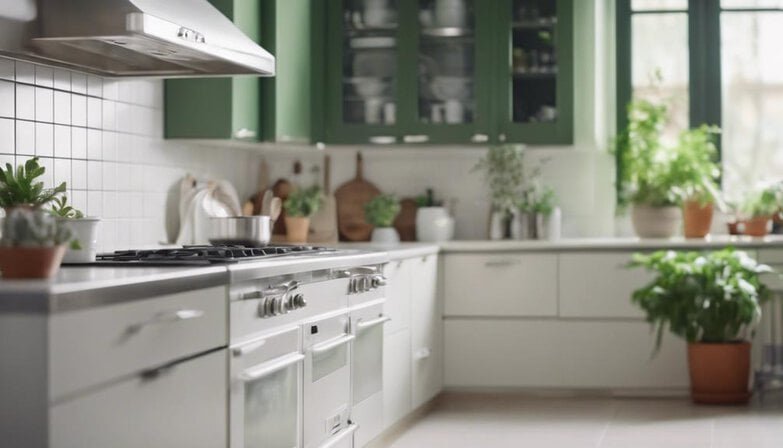
When considering mold-resistant paints for your interior walls, you'll find several advantages and drawbacks. These paints can help prevent mold growth in damp areas, but they may come at a higher cost and offer limited color choices.
Understanding the pros and cons will help you decide if they're the right fit for your home.
Pros
Why should you consider mold-resistant paints for your interiors?
Choosing mold-resistant paints offers numerous advantages, making them a smart choice for any home. To begin with, they provide excellent cost efficiency. These paints may have a higher initial cost, but they save you money in the long run by reducing the need for frequent repainting and repairs. Mold-resistant paints are formulated to prevent mold growth, which means fewer maintenance requirements and a longer-lasting finish.
In terms of durability factors, mold-resistant paints excel. They're designed to withstand damp and humid conditions, making them ideal for areas like bathrooms and kitchens. This durability ensures that your walls remain in top condition for years, providing you with peace of mind.
Additionally, mold-resistant paints come in a wide color variety. You won't be limited in your design choices, allowing you to express your personal style freely. The application ease of these paints is another significant benefit. They go on smoothly, requiring minimal effort and time to achieve a professional-looking finish.
Consider the following points to evoke a sense of freedom in your choices:
- Long-lasting protection
- Reduced maintenance hassle
- Versatile design options
Choosing mold-resistant paints can transform your home into a healthier, more beautiful space.
Cons
While mold-resistant paints offer numerous benefits, they also come with some notable drawbacks. One issue you might encounter is color fading. Over time, these paints can lose their vibrancy, especially in areas with high sunlight exposure. This means you might've to repaint more often than you'd like, which can be both time-consuming and costly.
Surface preparation is another challenge. Mold-resistant paints require a meticulously clean and dry surface to adhere properly. If your walls aren't prepared correctly, the paint may not stick well, reducing its effectiveness and durability. This means extra effort and time before you even start painting.
You'll also need to take into account the application tools. Mold-resistant paints often require specific brushes or rollers to apply evenly. If you don't use the right tools, you could end up with a patchy finish, which defeats the purpose of using this specialized paint.
Paint durability is another concern. While these paints resist mold well, they mightn't be as durable as other options. They can chip or peel more easily, requiring frequent touch-ups.
Lastly, think about the environmental impact. Some mold-resistant paints contain chemicals that aren't eco-friendly, which might be a concern if you're mindful about your environmental footprint.
Zero-VOC Paints for Interior Walls
When evaluating Zero-VOC paints for your interior walls, it's important to weigh both the advantages and disadvantages.
These paints are great for improving indoor air quality, but they may not always offer the same durability or coverage as traditional options.
Understanding these pros and cons will help you make an informed decision for your home.
Pros
Zero-VOC paints for interior walls offer a healthier choice by reducing harmful emissions in your home. When you choose zero-VOC paints, you're making an eco-friendly decision that benefits both your health and the environment.
One of the most significant pros of zero-VOC paints is their durability factor. These paints are designed to withstand the test of time, ensuring that your walls remain vibrant and fresh for years. Plus, you'll find a wide range of color options available, so you won't have to compromise on your aesthetic preferences.
The ease of application is another advantage. Zero-VOC paints often go on smoothly and require fewer coats, saving you time and effort. Maintenance needs are minimal, as these paints tend to resist stains and are easy to clean, making them a practical choice for busy households.
- Breathe easy: Enjoy better indoor air quality and a healthier living space.
- Protect the planet: Feel good about making an eco-friendly choice.
- Simplify your life: Appreciate the low maintenance and easy application.
Cons
Despite their many benefits, zero-VOC paints for interior walls do come with a few drawbacks that you should take into consideration. One of the main issues is the drying time. These paints can take longer to dry compared to traditional paints, which might postpone your project. Additionally, while zero-VOC paints are marketed as odor-free, some users report mild odor issues, especially during application.
Surface preparation is another critical aspect. You'll need to make sure the walls are thoroughly cleaned and primed, as zero-VOC paints can be less forgiving on uneven or dirty surfaces. This can make the application process more challenging, requiring more effort and precision. Moreover, coverage problems can arise, meaning you might need more coats to achieve a uniform finish, which can be both time-consuming and costly.
Here's a quick overview:
| Issue | Description | Impact |
|---|---|---|
| Drying Time | Longer drying periods compared to traditional paints | Delays project completion |
| Odor Issues | Mild odors reported during application | Possible discomfort |
| Surface Preparation | Requires thorough cleaning and priming | Increased prep time |
| Application Difficulty | Less forgiving on uneven surfaces, needs precision | More effort needed |
| Coverage Problems | May require multiple coats for uniform finish | Higher cost and time |
Considering these factors will help you make an informed decision about using zero-VOC paints.
Stain-Blocking Paints for Interiors
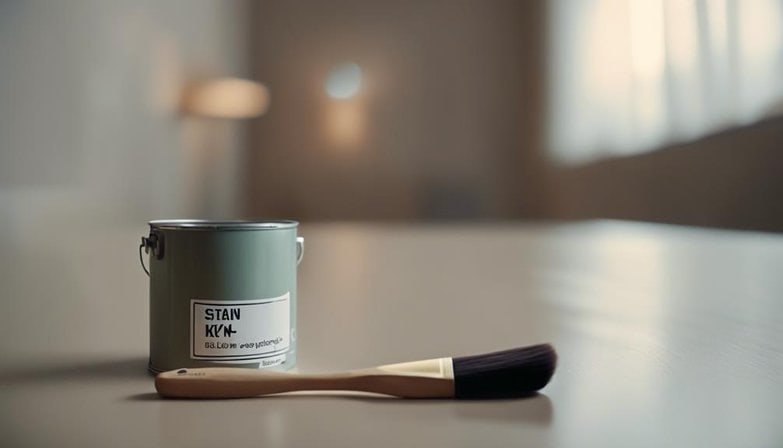
When considering stain-blocking paints for your interior walls, you'll find both advantages and disadvantages. These paints excel at covering stubborn stains and preventing them from bleeding through, offering a pristine finish.
However, they often come with a higher price tag and can be more difficult to apply compared to regular paints.
Pros
One of the key benefits of stain-blocking paints for interiors is their ability to effectively cover up and prevent the reappearance of tough stains. This means you won't have to worry about stubborn marks ruining your wall's appearance. These paints are designed with durability factors in mind, ensuring they stand the test of time even in high-traffic areas.
When it comes to color choices, you're not limited. Stain-blocking paints come in a variety of shades, allowing you to express your unique style without sacrificing practicality. Plus, many manufacturers offer eco-friendly options, so you can keep your home beautiful while being kind to the environment.
Application techniques for stain-blocking paints are straightforward, making the process easier for DIY enthusiasts. With quicker drying times, you won't be held back by lengthy wait periods, giving you more freedom to enjoy your refreshed space sooner.
Consider the following emotional benefits:
- *Peace of mind knowing your walls are protected from stains*
- *Pride in maintaining a clean, vibrant home environment*
- *Satisfaction from using eco-friendly products*
Choosing stain-blocking paints means embracing a practical, stylish, and environmentally conscious approach to home decor.
Cons
Although stain-blocking paints offer numerous benefits, they can be more expensive than regular paints, making them a less budget-friendly option for some homeowners. Besides the cost, there are other notable drawbacks to keep in mind.
Initially, color fading can be an issue over time, especially if the paint is exposed to direct sunlight. This might mean you'll need to repaint sooner than you'd like.
Another downside is the application difficulty. Stain-blocking paints often require more skill to apply evenly. You might need to use multiple coats, which increases both the time and effort involved. Additionally, surface preparation is essential. If the surface isn't properly cleaned and primed, the paint mightn't adhere well, leading to peeling or bubbling.
Drying time is another factor. Stain-blocking paints generally take longer to dry compared to regular paints. This extended drying time can be inconvenient if you're looking to complete your project quickly.
Paint and Primer in One for Interiors
When contemplating paint and primer in one for your interior walls, it's crucial to weigh the pros and cons. This type of paint can save you time and effort by combining two steps into one, but it mightn't always offer the best coverage or adhesion for tricky surfaces.
Let's break down the benefits and drawbacks to help you decide if it's the right choice for your project.
Pros
Using paint and primer in one for interiors greatly simplifies the painting process by combining two important steps into one. This makes it an excellent choice for those who value efficiency and freedom in their home projects. You'll find a wide range of color choices available, allowing you to express your creativity without the hassle of multiple applications. The application techniques are straightforward, making it easy even for beginners to achieve professional results.
When considering durability factors, paint and primer in one offers improved longevity, protecting your walls from wear and tear. Many options are eco-friendly, which means you can beautify your space while being kind to the environment. Cost considerations also come into play, as combining paint and primer can save you money in the long run by reducing the need for additional products.
Time-saving convenience:
Imagine finishing your project faster, freeing up your time for other activities.
Simplified process:
Less effort means you can enjoy the transformation of your space with less hassle.
Enhanced coverage:
Achieve a flawless finish with fewer coats, giving you a sense of accomplishment.
Choosing paint and primer in one empowers you to transform your interiors efficiently and effectively.
Cons
Despite its convenience, paint and primer in one can sometimes compromise on the quality of coverage, especially on previously unpainted or heavily stained surfaces. One significant drawback is color fading. Over time, the pigments may not hold up as well as those in separate primer and paint applications, leading to a less vibrant finish.
Another issue you might face is odor. Paint and primer in one often contain more chemicals, which can result in a stronger smell that lingers longer. This can be particularly bothersome if you're sensitive to odors or need to use the space immediately after painting.
Cleaning difficulty is also a concern. These products can be less durable when it comes to scrubbing and cleaning, making it challenging to maintain a pristine look. Surface imperfections, such as bumps or rough patches, might become more noticeable because the combined formula doesn't always level out as smoothly as a separate primer and paint would.
Additionally, you'll often experience long drying times, which can delay your project and leave you working around wet walls longer than you'd like. These cons are worth considering before opting for the convenience of paint and primer in one.
Metallic Paints for Interior Walls

When you're considering metallic paints for your interior walls, it's crucial to weigh the pros and cons.
On one hand, metallic paints can add a luxurious and unique finish that reflects light beautifully.
On the other hand, they can be more challenging to apply and may require multiple coats for full coverage.
Pros
Metallic paints for interior walls offer a unique, eye-catching finish that can transform any room into a sophisticated space. If you're looking to make a bold statement, metallic paints are an excellent choice. They not only create a stunning visual effect but also bring several practical advantages.
First, enhancing matters. These paints are known for their long-lasting nature, meaning you won't need to repaint frequently. Plus, many metallic paints are quick drying, so you can enjoy your newly transformed space sooner. Additionally, there are alternative options available, allowing you to beautify your home without harming the environment.
When it comes to cost differences, metallic paints might be a bit pricier upfront, but their benefits often outweigh the initial expense. The maintenance ease is another significant advantage. Metallic surfaces tend to resist stains and are easier to clean compared to traditional paint finishes.
With metallic paints, you can enjoy:
- A sense of luxury: Enhance your home's aesthetic with a high-end feel.
- Creative freedom: Experiment with different shades and textures.
- Enhanced lighting: Amplify natural and artificial light for a brighter space.
Cons
While metallic paints offer numerous benefits, they also come with several drawbacks worth considering. Initially, the drying time for metallic paints is typically longer than that for standard paints. You'll need to be patient and plan your project timeline accordingly.
Additionally, fading issues can arise over time, especially if the painted walls are exposed to direct sunlight. This can lead to an uneven and worn appearance, which mightn't be ideal for a long-lasting finish. Smell concerns are another factor to be aware of. Metallic paints often have a stronger odor compared to other types, which can be quite bothersome. Proper ventilation during application is essential but mightn't always be enough to mitigate the strong smell.
Surface preparation is also an important step when using metallic paints. You'll need to make sure that the wall surface is smooth and clean, which can be time-consuming and labor-intensive. Lastly, the application difficulty of metallic paints shouldn't be underestimated. Achieving a smooth, even finish requires skill and experience. Uneven brush strokes or roller marks can be more noticeable, making it harder to achieve the desired look without professional help.
Eggshell Finish Interior Wall Paints
Eggshell finish interior wall paints offer a middle ground between flat and glossy finishes.
You'll appreciate their subtle sheen, which adds a touch of elegance while being easier to clean than flat paints.
However, it's crucial to weigh the pros and cons to determine if this finish suits your needs.
Pros
When selecting interior wall paints, you'll discover that eggshell finishes offer a perfect balance between durability and aesthetic appeal. With their subtle sheen, they're perfect for those who want a classy, understated look that's also practical.
Eggshell finishes are known for their durability. They resist minor scuffs and marks better than flat paints, which means fewer durability issues over time. In terms of application techniques, they're relatively easy to apply, requiring fewer coats than some other finishes to achieve full coverage. This makes them both time-saving and cost-effective.
Color retention is another strong point for eggshell finishes. They maintain their color well, even in rooms that get a lot of sunlight, so you won't need to repaint frequently. For maintenance, simple cleaning with a damp cloth usually does the trick, making upkeep easy and stress-free.
Consider these factors to fall in love with eggshell finishes:
- Effortless Elegance: Achieve a refined, timeless look with minimal effort.
- Practicality: Durable and easy to clean, making life simpler.
- Cost-Effective: Save on both time and money with fewer coats and less frequent repaints.
Eggshell finishes truly offer a winning combination for your interior walls.
Cons
Despite their many advantages, eggshell finishes do have some drawbacks that you should consider before making a final decision. One of the initial things you'll notice is the drying time. Eggshell paint typically takes longer to dry compared to other finishes, which might limit your freedom to complete the project quickly.
Another issue is color consistency. Achieving a uniform color can be challenging, especially if you're not a seasoned painter. You might end up with streaks or uneven patches that require additional coats.
The paint odor can also be a concern. Eggshell finishes often emit strong fumes that can linger, making it less ideal if you're sensitive to smells or have limited ventilation.
Surface preparation is another factor to weigh. Eggshell paint demands a smooth, well-prepped surface for the best results. Any imperfections can become more noticeable once the paint dries, meaning you'll need to invest more time and effort in prep work.
Lastly, consider the cost. Eggshell finishes tend to be pricier than flat or matte options. While the durability is a plus, the higher upfront cost mightn't fit everyone's budget. Evaluate these factors to decide if eggshell paint is right for you.
Best Paints for Kitchen
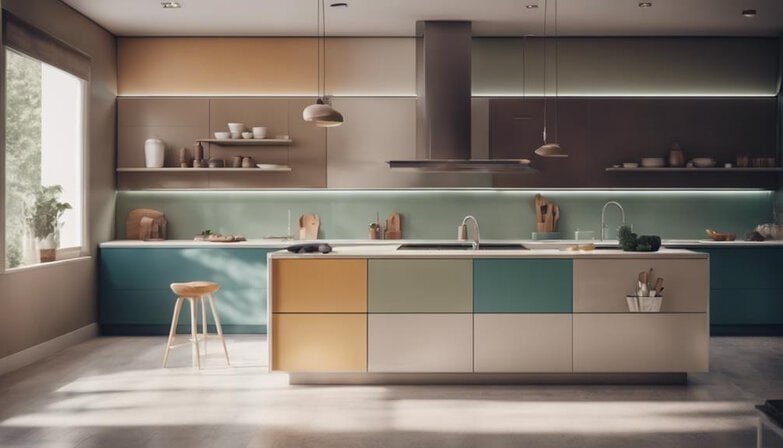
For your kitchen, selecting paint that can withstand moisture and stains is vital. When you're cooking up a storm, your walls need to be prepared for anything. Consider paints with excellent grease resistance, so splatters won't become permanent fixtures. Look for options with high cleaning ease, allowing you to wipe away messes without damaging the finish. Heat tolerance is also important, especially near your stove and oven.
Choosing the right color can make your kitchen feel inviting and vibrant. Light shades can open up the space, while darker tones add a touch of elegance. But beyond aesthetics, you need a paint that excels in stain prevention. This ensures that any spills or splashes don't leave lasting marks.
Here are three reasons to opt for the best kitchen paints:
- Peace of Mind: No more worrying about stubborn stains or damage from heat.
- Time Saver: Easier to clean, meaning less time scrubbing and more time enjoying.
- Freedom to Cook: Confidence to experiment in the kitchen without the stress of potential mess.
Pick paints designed for kitchens to keep your cooking space stylish and stress-free.
Best Paints for Kids Room
After delving into the kitchen, let's uncover the best paints for your kids' room, where durability and safety are crucial.
When selecting paint, consider color psychology. Bright, playful colors can stimulate creativity, while calming shades like soft blues and greens create a tranquil environment for sleep.
Whimsical designs add a touch of magic to your child's room. Think about using stencils or wall decals for patterns that can easily be changed as your child grows.
To guarantee their safety, opt for eco-friendly options. These paints have low or zero volatile organic compounds (VOCs), reducing harmful emissions and providing a healthier living space.
Kids are naturally curious and love to investigate, which often results in messy walls. That's why choosing a paint with a washable formula is vital. These paints allow you to easily clean off crayons, markers, and other surprises without damaging the finish.
Balancing aesthetic appeal with practical needs, you can create a beautiful, safe, and versatile space for your child. By focusing on these factors, you'll make sure their room remains a haven for both fun and relaxation.
Conclusion
In choosing the right interior wall paint, consider the specific needs of each room. Latex paints offer easy cleanup, while oil-based paints provide durability. Water-based options are eco-friendly, and acrylic paints deliver versatility.
For a hard, glossy finish, opt for enamel paints. Metallic paints add a touch of luxury. Eggshell finishes are great for low-traffic areas.
Kitchen paints should be moisture-resistant, and kid-friendly options should be non-toxic and washable. Make informed choices for the best results.


